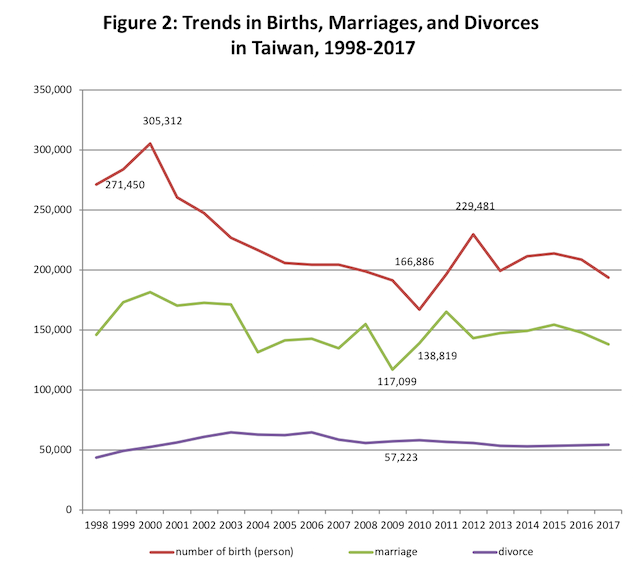Highlights
The total fertility rate (TFR) in Taiwan has been below replacement level since 1984, and it dropped to a historic low of 0.9 (with 167,000 babies born) in 2010. What happened in 2010? According to Chinese zodiac heritage, it is because people were conventionally unwilling to get married and have children in the year of the Tiger.1 In fact, fewer people get married during a global financial crisis, as well as after natural disasters, which is what we experienced when the Typhoon Morakot lashed Taiwan in August 2009 and worsened the economic situation of the country.
Due to the rapid changes in the population structure, the government was particularly concerned about this trend of decreasing fertility. Beginning in May 2008, the government began taking some measures to boost fertility, when Kuo Min Tang took power. These measures included: a 6-month parental leave policy with 60% payment for both parents, a tax reduction for families rearing children ages 0 to 5, a nursing and childcare subsidy, and more—all enacted after 2009. Between 2011 and 2016, the TFR in Taiwan rebounded to 1.2 and the number of births rebounded to 210,000, on average. Although Taiwan's TFR was still listed as one of the lowest in the world by the United Nations, the bounce back was important for Taiwan in terms of the previous trend of low fertility (see Figure 1).

Source: Ministry of the Interior, Department of Statistics, Taiwan
The end of the fertility decline during 2011-2016 could be attributed to the recovery from the depression and the government’s pro-fertility measures. For instance, the birth disparity between 2000 and 1998 was just over 33,000 babies, while 2012 resulted in about 63,000 babies, more than that of 2010 (see Figure 1, the read curve). The government at that time tried to work toward a goal of 200,000 babies as the bottom line in order to keep TFR no lower than 1.2 and to alleviate the aging trend.
It is also worthwhile to note that only 3 to 4% of babies were born outside of marriage over the past two decades in Taiwan. In February 2009, I was appointed as Minister Without Portfolio2 in charge of population policies, so I began to watch the changes in marriages, divorces, and births. I also spoke with leading obstetricians/gynecologists about the timing of childbearing among married couples. A large share of doctors said that around half of births take place within a year after marriage in Taiwan. Accordingly, I was able to make a good prediction for the number of births for the next year by adjusting the projection done by the National Development Council (NDC). In short, marriage and divorce can be used, to some extent, as leading indicators for births in the coming year, particularly since 2001 is when most married young couples had only one child (see Figure 2).

Source: Ministry of the Interior, Department of Statistics, Taiwan
As Figure 2 shows, the number of marriages rapidly dropped from 155,000 couples in 2008 to 117,000 couples in 2009, the year of Taiwan’s abysmal depression, which resulted in very low fertility in 2010. The government encouraged young people to get married when the economic situation began to show signs of recovery, which successfully resulted in over 21,000 more marriages in 2010 than in 2009, plus an additional 26,000 marriages in 2011. This increase in marriage in both 2010 and 2011 resulted in a jump in births in both 2011 and 2012.
In May 2016, the Democratic Progressive Party won the presidential election and soon changed some of the social policies of the previous administration. The previous pro-natal policies focused on the value of family and were labeled as "conservative," while the new administration was more focused on enacting more “progressive” laws, including promulgating a law to legalize same-sex unions. I believe the government’s focus on this issue took needed attention away from our nation’s more pressing problem, our declining birth rate, which has been aptly called a “National Crisis.”
Not surprisingly, the new government recently announced that the number of births for 2017 is 193,000 babies—and the TFR has fallen to 1.0.3 As I predicted a year ago, 2016 could be the last year we see 200,000 new babies born. I am concerned that in the years to come, Taiwan won't have the 200,000 new babies it needs to continue to grow, while the aging trend will continue to increase over the next 40 years. The trend indicates more loss of manpower and the surge of retirement pensions, as well as the need for long-term care and Medicare. According to NDC's projection, the aging population will account for 20% and 40% in 2025 and 2060, respectively. As a result, it is very likely that Taiwan will become the oldest country in the world by 2060.
James C.T. Hsueh is a professor in the Department of Sociology at National Taiwan University.
Editor's Note: The views and opinions expressed in this article are those of the author and do not necessarily reflect the official policy or views of the Institute for Family Studies.
1. Chinese Zodiac signs include the rat (2008), the ox (2009), the tiger (2010), the rabbit (2011), the dragon (2012), the snake (2013), the horse (2014), the sheep (2015), the monkey (2016), the rooster (2017), the dog (2018) and the pig (2019). According to the legend of Buddhism, the Buddha gave each animal a year in the 12-year cycle and declared that one born in that year would prerequisite the animal's characteristics in some way. The years in the brackets indicate the recent cycle.
2. The Minister Without Portfolio is one of the cabinet members in Taiwan.
3. The TFR for 2017 is not yet reported by the government, and 1.0 was calculated by the author.













